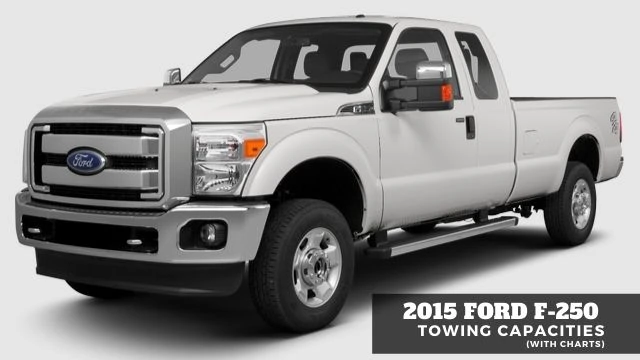The 2015 Ford F250s did not have the towing capacity that some of the later model year trucks had, but we're still quite impressive when it came to the overall ratings.
On the high end, a properly equipped truck could haul up to 16,600 lbs. which is quite impressive for a three-quarter ton truck. On the flip side though, some models were only able to achieve a rating of 12,100 lbs. which is still a lot, but more than 4,000 pounds less than the maximum weight rating. This article walks you through all of the different variables and explains just about everything you need to know.
Be sure you read your owner's manual to get familiar with your truck and remember to follow all of Ford's recommendations and requirements.
2015 F-250 Overview
Overall Towing Capacity: The towing capacity for the 2015 Ford F250s ranged from 12,100-16,600 lbs. and really boiled down to what engine you had equipped in your truck, what type of hitch you were using and what axle ratio you had.
Engine Options: There were only two different engines that you could choose from for these model year trucks and this was either a 6.2L A gasoline-powered engine or an upgraded 6.7L diesel engine. The engine you had equipped really did make the biggest difference when it came to the capacity numbers listed in the charts.
6.2L Engine: The 6.2 L engine had respectable ratings but did not quite meet the 6.7 liter engines specs on the high end. If you had a 6.2 L engine equipped in your truck, then you could expect to see a range of between 12,100-15,900 lbs. of pulling capacity, which wasn't too shabby considering the diesel engine's specs.
6.7L Engine: If you had the 6.7 L diesel engine equipped your truck, then you had a slightly increased overall towing capacity that ranged from 12,500-16,600 lbs. So you had about 400 lbs. more capacity on the lower end of the spectrum and about 700 lbs. more capacity on the higher end, compared to models that had the 6.2 L engine option.
Axle Ratios: Overall, there were four different axle ratios that were available for these trucks and each engine option had two different axle ratios to choose from.
For trucks that had the 6.2 L engine option, they had the choice between either a 3.73 axle ratio or a 4.30 axle ratio. For trucks that had the 6.7 L diesel engine equipped, your to axle ratio choices boiled down to either a 3.31 ratio or a 3.55 ratio.
Assumed Weight: If you look in the guide that Ford offers oh, they do specify and assumed wait for these trucks and all of their other vehicles when specifying the maximum trailer weight ratings. For the 2015 model year, Ford only assume the weight of a driver, which was assumed that 150 lbs. And did not include any additional weight in the vehicle in the form of additional passengers, cargo or aftermarket equipment.
If you have any additional weight in the vehicle other than a driver that weighs 150 lbs. or less, you will have to deduct that weight from the maximum trailer weight ratings, in order to get an adjusted figure.
Standard and 5th Wheel/Gooseneck Charts:
The 2015 Ford F250s shared their charts with the F-350s and the F-450s, so I went ahead and highlighted the specs for the F250's in the red boxes in the charts below. There are two different charts listed below, which is how Ford lists most of their truck's data and the top chart is for conventional hitches while the chart below that is for fifth wheel and gooseneck hitches.
There is a lot of data to go through in the charts, which we will be going through in this article. In order to find your maximum trailer weight rating, you will need to plug in certain aspects of your truck like the cab style, the engine you had equipped, the axle ratio and whether you had a four-wheel drive or two-wheel drive model.
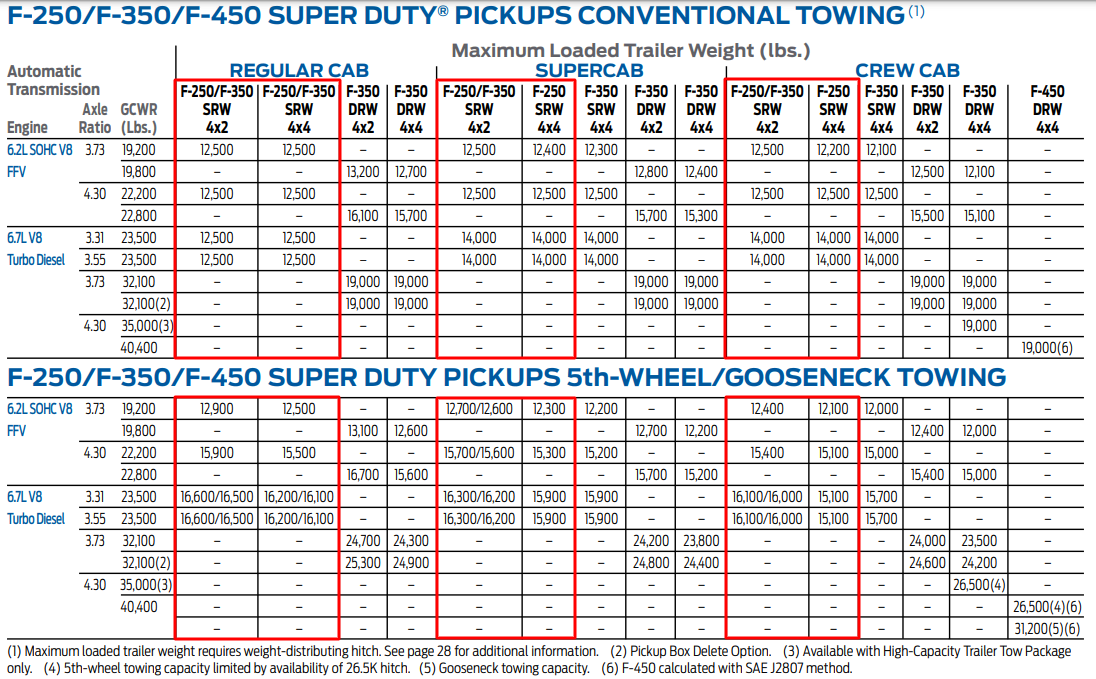

Conventional Hitch: If we look at the data in the top chart or the conventional tow specs, we can see that the overall maximum trailer weight ratings were quite a bit less on the higher end, compared to the fifth wheel and gooseneck chart. For conventional hitches, the capacity numbers ranged from 12,200-14,000 pounds.
I do want to point out that if you are looking to achieve those higher-capacity ratings, then you will have to have a weight distributing hitch included in your set-up in order to achieve those ratings.
If you do not have one of these hitches set up, then your maximum limits are substantially less, depending on what engine you have equipped in your vehicle. We will go more into these details later in the article and you will see what I'm talking about.
5th Wheel/Gooseneck Hitch: The 5th wheel and gooseneck chart had higher ratings than the conventional specs, having a range of between 12,100-16,600 pounds, but I was surprised to see that it was less capable on the low end of the spectrum, having a 100 lb. difference from the lowest rating on the conventional chart.
Pay Attention To The Notes...
There was a small note at the top of the conventional chart that was labeled with a small number one and if you read the notes at the bottom of that chart, you can see that these weight ratings did require a weight distributing hitch in order to achieve most of the higher figures in the chart.
This is what the note read exactly: (1) Maximum loaded trailer weight requires weight-distributing hitch.
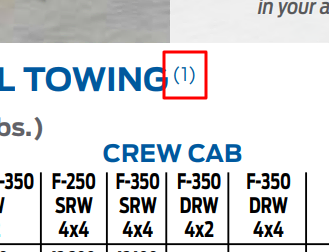
Hitch Weight Options and Ratings:
All of the tow equipment that you usually need came standard on these trucks, which is really nice and I was able to find some information on what is included as far as the hitch goes, along with some other notes that you might find useful.
Later in this article, I do list the standard equipment that comes with the vehicle as well, so you can scroll down to look for that if that's what you're looking for.

I did mention that in the conventional chart, the higher ratings were only achievable if you had a weight distributing hitch installed. I was able to find a hitch receiver weight capacity chart that lists the maximum trailer capacity ratings if you did not have one of these hitches installed, and as you can see it was reduced down to 6,000 pounds if you had the 6.2 L engine and only 8,500 lbs. if you had the 6.7 L diesel engine equipped.
These figures are substantially less than the 12,500 pound rating that was listed for the 6.2 L engines with a weight distributing hitch and the 14,000 lb. rating that was lifted for trucks that have the diesel engine option installed.

Tongue Weight Ratings:
The tongue weight ratings could be found at the bottom of the charts and I went ahead and enlarged the image so if you click on it, you can read the very small text that Ford used.
Ford stated that the trailer tongue load weight should be 10 to 15% of the trailer's overall weight, if you were using a conventional hitch and they increased that amount from 15 to 25% if you were planning on using a fifth wheel or gooseneck hitch.
On a side note, Ford does not recommend going below or above these percentages as it could cause unsafe driving conditions.

Other Specs To Consider:
I also went ahead and listed the trailer frontal area considerations that Ford specified, along with the tailgate clearance heights, for anyone out there who plans on using a fifth wheel or gooseneck type of setup.
Trailer Frontal Area Considerations

Cab Styles...
You will have to match up the cab style that you have on your specific truck with the image below in order to find what cap style you had. This is an important metric and is one of the many variables that you need to decipher in order to get an accurate maximum trailer weight rating from the chart.
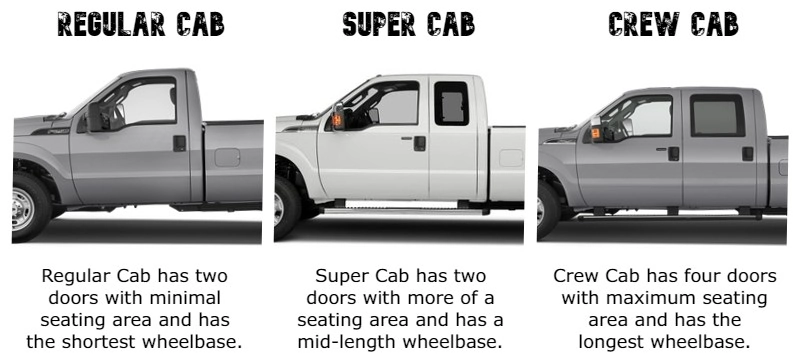
How The Engines Stack Up...
I was also able to find this spec sheet that tells you a little bit about the two different engine options that were available for these model year trucks. The engine you had equipped in your truck did matter when it came to the trailer weight ratings, but the data below will not affect anything in the charts, I just thought it would be helpful to some people out there that may want to know their specs.
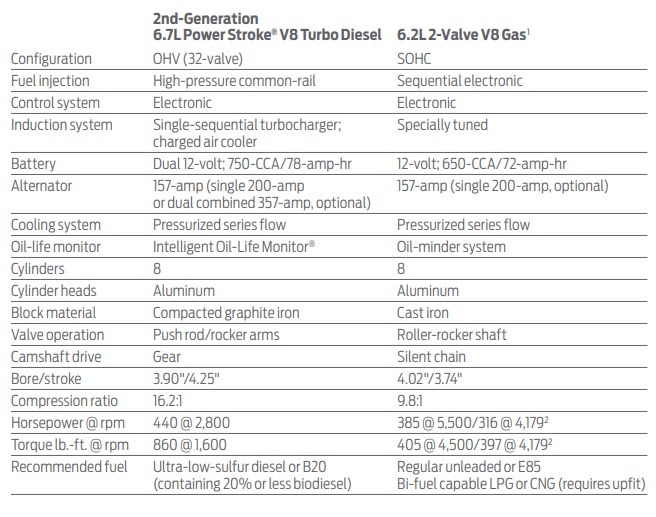
(1) Certified to SAE J1349. (2) 405 lb.-ft. of torque and 385 hp, 10,000 lbs. GVWR and under. 397 lb.-ft. of torque and 316 hp, 10,001 lbs. GVWR and over
What Axle Ratio Do I Have?
Another variable that you are going to have to figure out is what axle ratio you have equipped on your truck. This can be found on the certification label that is located on your driver side door jamb or the door itself and it looks very similar to the label I have shown in the image below.
Once you find that label, look along the bottom of it, in the middle of the label and you will see the word axle and then below that you will see a two-digit code that will consist of either numbers or a number and a letter. You will need to take note of this code and then you will have to decipher the code in the chart that Ford provided.

If you look at the image I have posted below, you can see that this chart has the rear axle ratios listed on the left-hand column, along with three additional columns that list the axle codes that can be found on various Super Duty trucks, along with the three different types of axles that Ford offers.
All you have to do is plug in your 2-digit code into the chart and it will tell you what your rear axle ratio is. There were only four different axle ratios that were available for the F-250 trucks, which are the ones I highlighted in the red boxes. Remember, this chart shares the axle ratios for all Super Duty trucks and is why there are other axle ratios listed.

SRW vs DRW:
Since the chart is shared with other F-series trucks, you may have noticed two different labels that were labeled as SRW and DRW. These just simply refer to how many wheels you had on the rear axle.
SRW is short for single rear wheels, in which case you'd only have two rear wheels and DRW stands for dual rear wheel, where you would have four rear wheels in total, which most people refer to as a dually.
All of the Ford F250s were single rear wheel trucks and did not have the option of dual rear wheels.
Do You Have a 4WD or 2WD Truck?
You will also need to specify whether you had a four-wheel drive or two-wheel drive model because the specs were a little different, in some cases. This should be simple for most people to figure out, but if you are confused on whether you have a two-wheel drive or four-wheel drive truck, then you could just simply look on the dash or somewhere around the console area to see if you have a four-wheel drive button or buttons.
If all else fails, then I recommend you take your truck into a dealership to have them verify whether you have a two-wheel drive or four-wheel drive configuration.
Let's Dive Into The Trim Levels...
There were five different trim levels available for the 2015 F250s, which you can find listed in the super duty brochure and it lays out all of the information as far as what options are available for what trim levels on these trucks. The five different trim levels were listed in the brochure as the: XL, XLT, Lariat, King Ranch and Platinum models.
I do want to point out that the trim level you had equipped on your truck did not really affect the capacity numbers, as each trim level had the ability to have both engine options.
Engine Availability: As I stated before, all of the trim levels had the option of having the 6.7 L engine equipped in the vehicle and I assumed that the 6.2 L was the standard option, but they gave you an available option of having the diesel engine installed instead.

Available Packages: The super duty brochure also listed what the available packages were for these trucks and I was able to take a screenshot of the two main packages that were offered for all trim levels.
One of these was a package for a fifth wheel or gooseneck setup, which consisted of all the basic items you would need if you were wanting to pull a trailer with this type of hitch setup.
Another package that was listed was the 9,900 lb. gross vehicle weight rating package, which didn't seem to affect the trailer weight ratings and I assume it was geared more towards the payload capacity of the vehicle.

GCWR, GVWR and GAWR Figures:
GCWR: The gross combined weight ratings were specified in the charts and it made things really convenient, as far as getting that information. I do want to point out that there were a couple of notes on some of the gross combined weight rating specifications, as you can see in the image below, but these were for different F-series trucks and did not apply to the F250s.
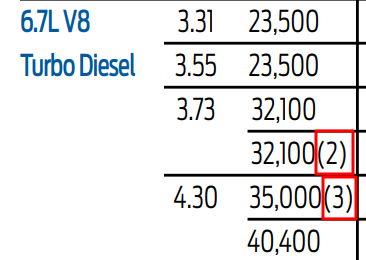
(2) Pickup Box Delete Option. (3) Available with High-Capacity Trailer Tow Package only.
GVWR & GAWRs: If you are wanting to know the gross vehicle weight rating or gross axle weight rating of your truck, you will not find this information in the charts or any other literature that is available online. You will have to look on your truck in order to find these two figures, which are located, again, on the certification label, which is also where we found the axle code earlier.
If you look on your certification label, at the very top of the label is where you will find the gross vehicle weight rating and the gross axle weight ratings for the front and rear axles. The image below outlines where you can find all this information on the label.
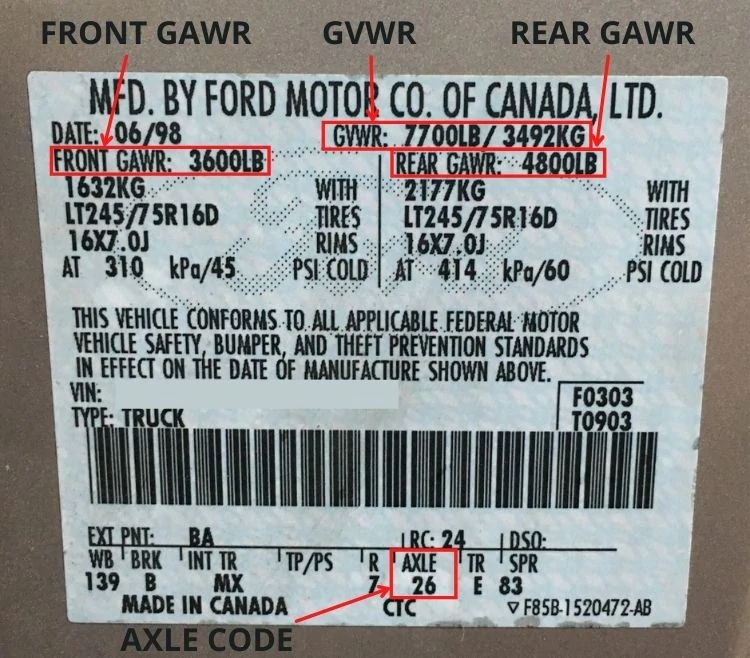
Standard Equipment & What's Included...
I was also able to find what standard equipment came equipped with these trucks and if you look at the chart below, you can see that most of the required equipment was a standard option that you did not have to pay extra for. You pretty much get all the basic accessories you need, the only thing I noticed that you do not get is a brake controller, which was only offered as a standard option on other F-series trucks.
You will need to have a brake controller installed in your truck though if you are planning on pulling more than 1,500 lbs. because Ford requires that you have trailer brakes equipped on your trailer if the weight of the trailer is 1,500 lbs. or more and driving a trailer that has trailer brakes equipped without a controller is not a good idea.
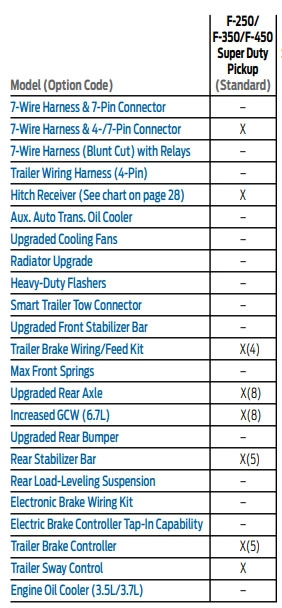
(4) In-cab, no controller (SRW). (5) F-350 DRW; F-450 (8) F-450 only.
Trailer Brakes:
As I mentioned earlier, Ford requires that you have trailer brakes installed on your trailer if your trailer weighs 1,500 lbs. or more. Remember, your vehicle's braking system is only designed to stop your vehicle when it is within its gross vehicle weight rating. The additional weight that pulling a trailer puts on your truck's braking system would be too much to handle and you would likely get yourself in a situation that would be very scary.
On a side note, each state will have different laws on what they require as far as trailer brakes and trailer weight ratings, so you want to check what those requirements are and make sure you follow your local enforcement requirements as well.
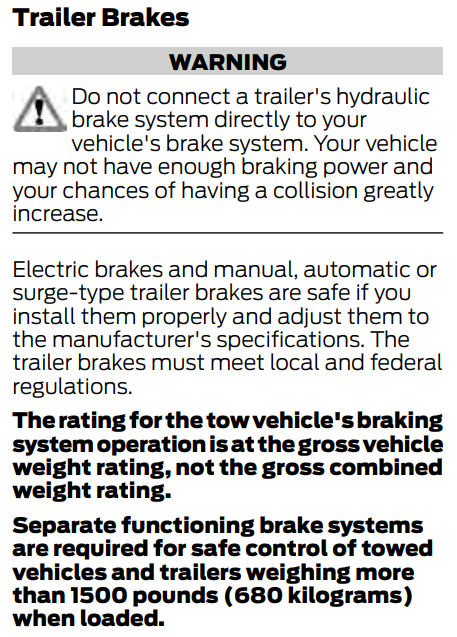
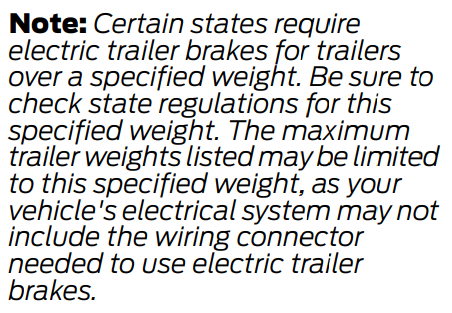
Other Notes I Found:
I was also able to find additional information the talks about higher altitude areas and how areas like this can affect your truck's overall power. Ford requires that you reduce your gross combined weight rating by 2% for every 1,000 feet of elevation change (uphill), in order to compensate for the loss of power that your vehicle may encounter.
The other note talks about minimum octane ratings of gasoline, which would only apply to models that have the 6.2 L engine equipped. Ford recommends a minimum octane rating of 87 and does not recommend that you fuel up your truck with anything less than an octane rating of 87.
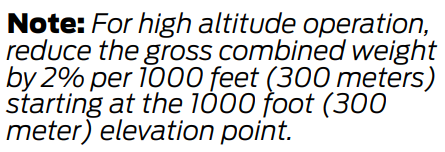
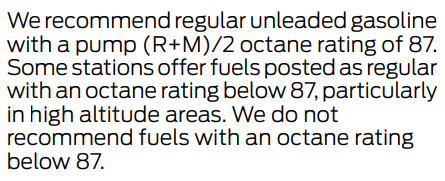
Helpful Links:
All of the information I gathered for this article came directly from three different resources that I found online and all three were brochures and manuals that Ford provided. I went ahead and listed these three resources below for those of you out there that want to check them out for yourself.The tow guide was probably the most helpful resource and is where I gathered most of the images I have posted in this article. The owner's manual was also very helpful, along with the super duty brochure that really helped out when it came to the different trim levels and what available options were offered for each trim level.
Last updated on April 27th, 2022 at 06:46 pm
